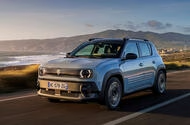The Renault 4 is making a comeback after a three-decade break, and it’s stepping into the spotlight as a practical electric crossover. But how does this new version stack up against the beloved classic that sold over 8 million units? Let’s dive into the details and see what makes the new R4 both familiar and refreshingly different.
What Makes the New Renault 4 Stand Out?
Renault is touting the new R4 as a thorough reinvention, and they’re not wrong. This electric crossover is designed with versatility in mind, boasting a lengthier frame than the new Renault 5, which it shares a platform with. This means more room for passengers and their gear. With a boot space of 420 liters, it offers 100 liters more than the Renault 5, making it one of the most spacious options in its class. Plus, there’s an underfloor compartment for charging cables, which is a thoughtful touch for those who want to keep their trunk tidy.
The ground clearance is another plus, giving it a more rugged feel that could appeal to urban adventurers and families alike. It’s clear that Renault has put a lot of thought into making this car practical for everyday use.
How Does It Compare to the Classic R4?
While the new R4 is versatile, it’s essential to acknowledge how different it is from its predecessor. The original R4 was a global phenomenon, often referred to as the “blue jeans car” for its widespread popularity and accessibility. It was known for its simplicity and durability, with a robust four-cylinder engine that could easily last 30,000 miles without a service and often surpassed the 500,000-mile mark. Even today, you can spot these classics cruising through North Africa, a testament to their reliability.
In contrast, the new R4 will be produced exclusively in France, with a significant portion of its parts also sourced from there. While Renault plans to market the vehicle in Europe, South America, and Japan, the lack of electric infrastructure in many regions could limit its reach. This shift from a globally produced vehicle to one with a more localized manufacturing approach marks a significant departure from the original model’s ethos of accessibility and widespread availability.
What About the Electric Aspect?
The transition to electric is a big part of the new R4’s identity. As the automotive industry shifts toward sustainability, Renault is positioning the R4 as a practical option for eco-conscious consumers. However, the success of this model will largely depend on the development of charging infrastructure. In areas where electric vehicle (EV) support is lacking, potential buyers might hesitate, which could impact sales.
Renault’s commitment to electrification is commendable, but it raises questions about how well the new R4 can replicate the original’s charm and practicality in a world that’s still adjusting to electric mobility.
What Can We Expect Moving Forward?
The new Renault 4 is a fascinating blend of nostalgia and modernity. It retains some of the versatility that made the original a household name while embracing the electric future. As consumers become more environmentally conscious, the demand for practical electric vehicles will likely grow. Renault’s challenge will be to ensure that the new R4 not only meets the expectations set by its predecessor but also adapts to the evolving needs of today’s drivers.
The big takeaway? The new Renault 4 isn’t just about reviving a classic; it’s about embracing change while holding onto the essence of what made the original so beloved. Whether you’re a fan of the old model or curious about the electric future, the R4 is poised to make its mark. Start by exploring its features, and you might just find that this modern twist on a classic has something special to offer.

